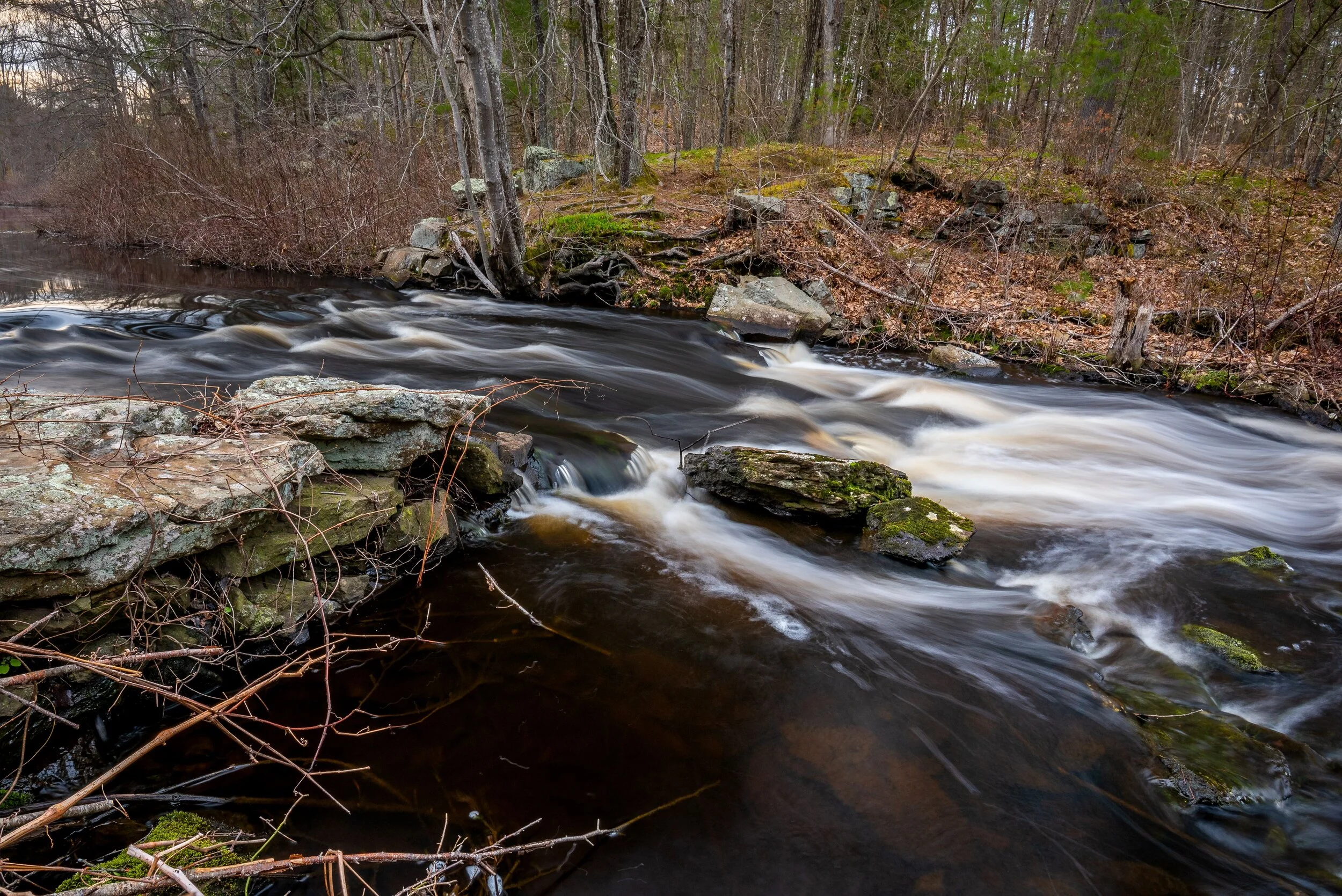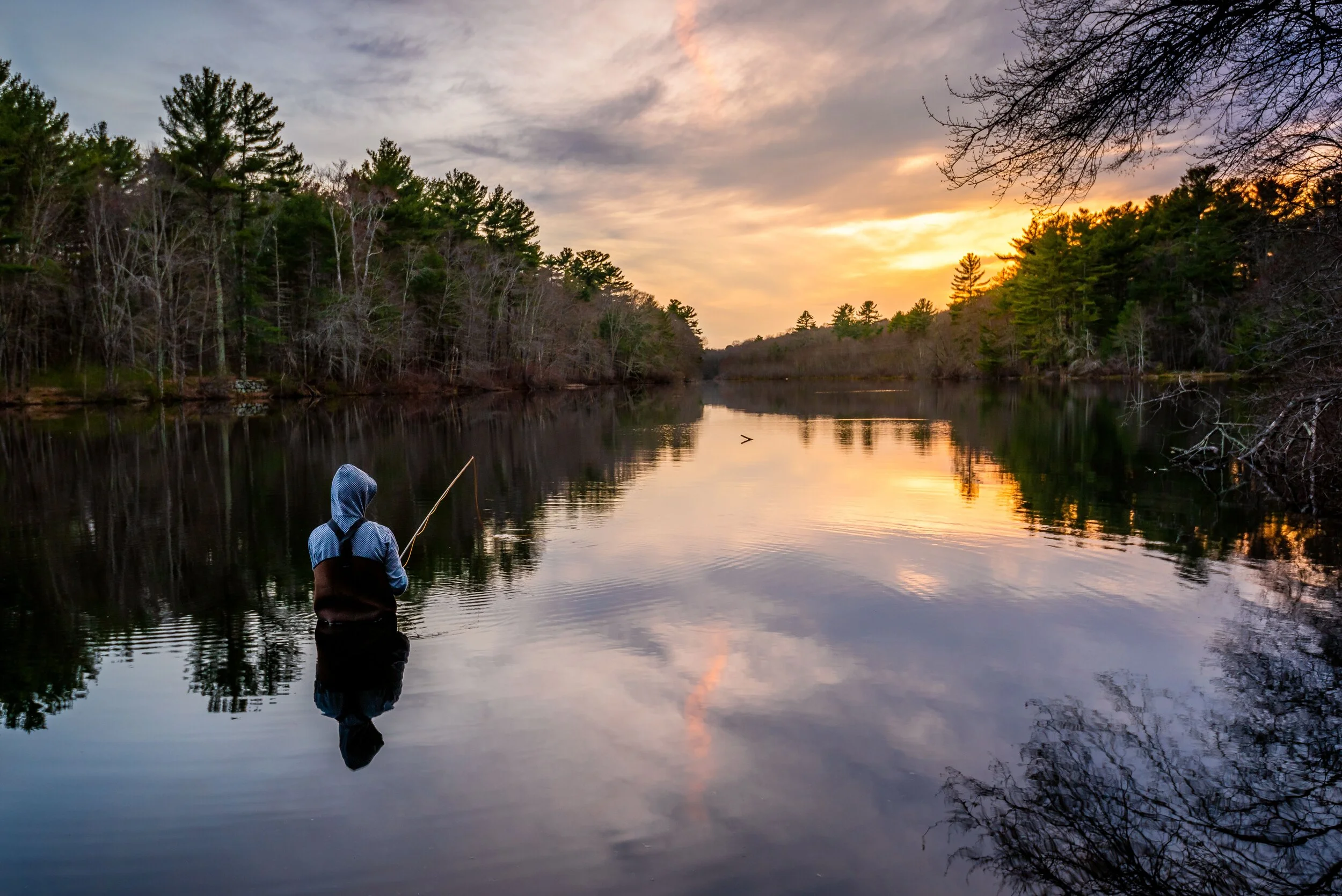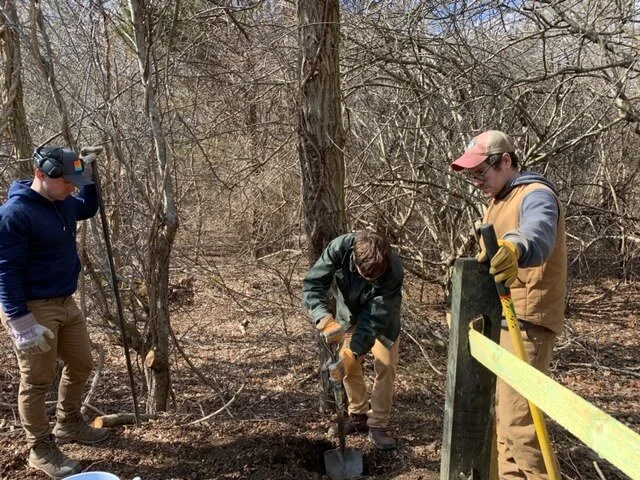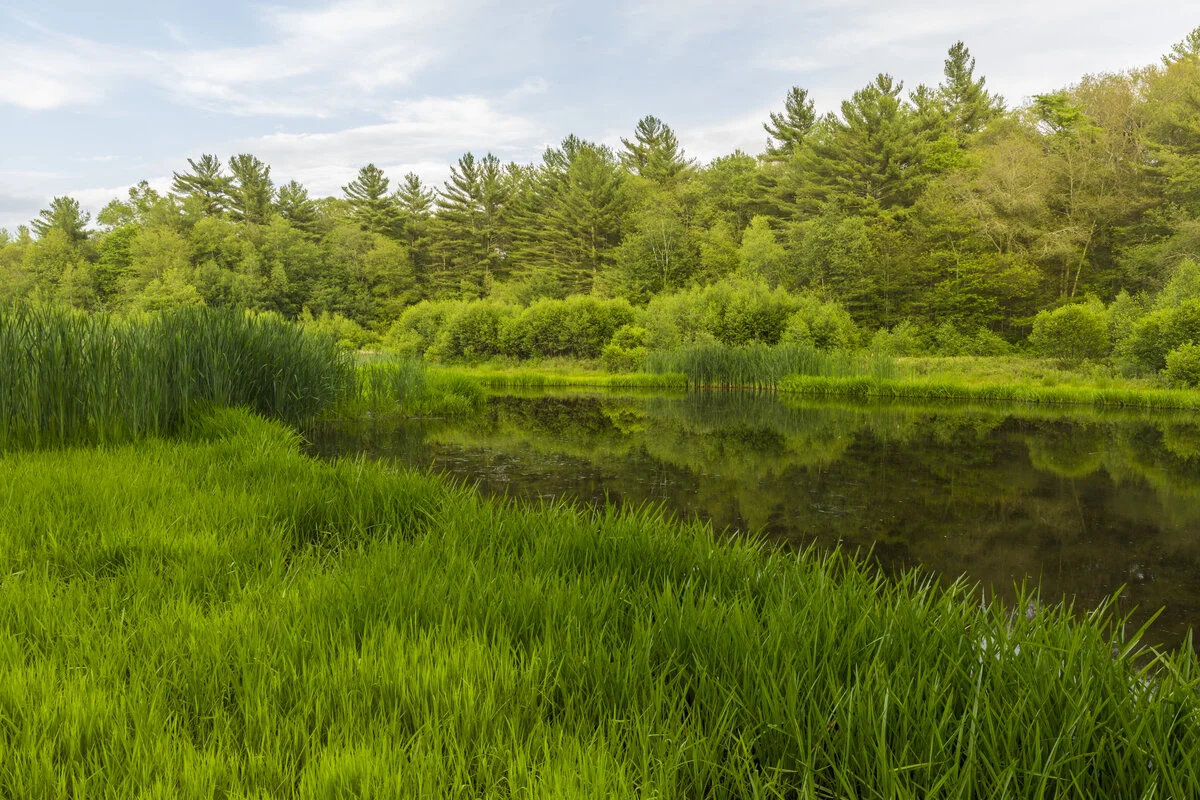What’s New at Wildlands
Volunteers Cleanup Pembroke, Hanover, Hanson Preserves
On April 24, volunteers led by members of the Indian Head River Coalition banded together to remove trash along the banks of the Indian Head River, Rocky Run, and North River, as well as from the conservation properties they run through.
Volunteers initially met at Luddam’s Ford Park (Hanover) prior to breaking out into groups that would focus on five locations selected at conservation lands in Hanson, Hanover and Pembroke. Volunteers in Hanson cleaned along State Street and Rocky Run, with a notable find being an old TV they pulled out of the river. Three locations were selected in Hanover for groups to canvass, including Water Street, the Luddam’s Ford Park parking lot and Chapman’s Landing. In Pembroke, volunteers cleaned-up Luddam’s Ford Park (Pembroke) and Tucker Preserve.
In total, 25 bags of trash were removed from these areas. Items collected included everything from bottles, cans, mylar balloons, furniture cushions, and even a steel oil tank! Thank you to everyone who volunteered their time and spent the day with the Coalition in order to help keep the river system clean and healthy.
About the Indian Head River Coalition
The Indian Head River Coalition was created in 2017 for the purpose of preserving the historic and natural qualities of the contiguous conservation lands along the Indian Head River and engage the general public in taking advantage of passive recreational opportunities on these properties. The Coalition is composed of Wildlands Trust, the North and South Rivers Watershed Association, and the towns of Hanover, Hanson and Pembroke. In 2018, the group obtained a Recreational Trails Program (RTP) grant to provide trail maintenance, trail markings, amenity improvements, and new kiosks and interpretive signage along the 6-mile trail corridor that runs through and connects each property.
Annual Fencing Goes up at Shifting Lots
In preparation for the expected uptick in visitation at Shifting Lots Preserve, Stewardship Manager Erik Boyer and Wildlands volunteer and board member Marilynn Atterbury spent a day out on the property this past week installing temporary fencing along the dunes. This work is done in tandem with the Friends of Ellisville Marsh, who install fencing along the front portion of the property in order to protect the nesting sites of piping plovers and least turns.
In addition to creating space around the nesting sites to prevent scaring the birds away, the fencing also helps visitors avoid accidentally stepping on their eggs when walking along the shore. Just as we ask visitors to stay on trail at our wooded preserves, we ask that if you visit the property, please be mindful that this area is an important habitat for the survival of these creatures and keep out of the fenced-off areas. As in past years, this fencing will remain up until October.
If you’d like to learn more about threatened shorebirds at Shifting Lots and Cape Cod, you can check out the recording of our recent Zoom presentation on our website: https://wildlandstrust.org/wildlands-online.
Indian Head River Trail Enhancements Continue Thanks to the Efforts of Many
Following centuries of changes along the Indian Head River, the towns of Pembroke, Hanson and Hanover work together with Wildlands Trust to improve the surrounding trail system with a MassTrails Program grant.
By Community Stewardship Program Manager Conor Michaud
Rivers are the multi-tool of the natural world, harnessed by people, they support burgeoning populations and have played a key role in shaping our civilization. Before industrialized society, rivers were free-flowing. Unobstructed by dams and development, these waters naturally deposited nutrients and sediments along the river corridor, housed essential native breeding grounds for migratory fish and provided for a biodiverse ecosystem. Today, free-flowing rivers are globally threatened, with only several remaining in Massachusetts and the North River being the only one in Wildlands’ service region.
What remains of the Waterman Tack Factory dam rest along the shores of the IHR.
The Indian Head River (IHR), a tributary of the North River, was transformed from its free-flowing state centuries ago. Throughout the 17th century and up until the early 20th century, the IHR fueled the local economy and proved an invaluable resource. As industry left the river, mills eventually ceased production, dams collapsed and the forges cooled. The train which once ran along the shoreline is long gone, its former path converted into a nature trail some years ago. For nearly four miles, the river now flows peacefully through Pembroke, Hanover and Hanson, and in many places, large swathes of the riparian corridor and forests have been conserved to help protect this treasured habitat.
In 1993, Wildlands was gifted Tucker Preserve in Pembroke, one of Wildlands’ most popular conservation areas. The northern side of Tucker sits against the IHR, affording hikers stunning views and fishing access, while the southern upland forest showcases shady hemlock stands and old rock walls, vestiges of former agricultural land. The three towns through which the IHR flows — Pembroke, Hanover and Hanson — have each conserved land along its banks and in 2018, Pembroke received funding from the Department of Conservation and Recreation’s MassTrails Program to improve the trail system on the surrounding conservation lands and increase public stewardship along the river. Over the last two years, Wildlands has managed the IHR Trail Project for the town, working with representatives from Pembroke’s conservation commission, Hanover and Hanson’s open space committees, Hanover’s Department of Public Works, and the North and South Rivers Watershed Alliance to enhance the 4-mile trail loop encircling the IHR.
The Indian Head River flowing east from State Street.
Adequately protecting the IHR, its riparian areas and nearby upland forests requires more than trail stewardship though, it requires volunteer contributions and the devotion of local residents who will continue to assist in conservation efforts long after the MassTrails grant is complete. Throughout the IHR Project, Wildlands has focused on public outreach through guided hikes, volunteer trail work events and recruitment of volunteers to our Adopt-A-Preserve program. From these efforts, a tremendous amount of volunteer support has been shown, with over $7,000 of volunteer match time collected. Most recently, local photographer Andrew Lederman generously donated his time and skills to document the preserve’s natural beauty, as well as the remnants of the IHR’s former industrial life (featured in this article). Earlier this spring, Hanover’s Department of Public Works assisted Wildlands in creating a formal parking area along Water Street, a welcome addition as trail usage continues to grow, and this summer, Wildlands will work with a boy scout from Hanover to install new trailhead kiosks and educational signs along the trail system.
Massachusetts has a long industrial history, from the massive farming culture during the 18th and 19th centuries, to mills and factories that dammed our rivers, altered the landscape and ultimately shaped our communities. The IHR Conservation Area and the IHR Trail Project are opportunities for us to study our industrial past and the impacts of having manipulated the formerly free-flowing river. The IHR Conservation Area provides a space to track the native fish species which struggle to navigate the Luddam’s Ford fish ladder, shedding light on the impacts of dams and the benefits of protecting natural free-flowing rivers. Most importantly, the IHR Trail Project demonstrates a collaborative success and the importance of spanning town boundaries to protect what little conservation land remains in our rapidly developing towns.
The Indian Head River is an incredible resource and outdoor enthusiasts, anglers and families seek its utilities all year long. Offering miles of trails, fishing, picnicking and water craft recreation, the IHR stands out as a top nature destination in the South Shore. With the recent COVID-19 pandemic, Wildlands has seen a surge in trail users. On weekends, the parking lots are often filled and the shores are lined with hopeful fishermen and women. Wildlands reminds you to please stay on marked trails, pickup and carry out your dog’s waste, and respect fellow hikers by following social distance guidelines. Our work at Tucker Preserve and the IHR is successful because of our dedicated volunteer base and the people who respect these natural spaces. If you are interested in learning how you can help protect your conservation land please send us an email (info@wildlandstrust.org) or give us a call (774-343-5121).
Willow Brook Updates Begin
Wildlands stewardship staff, with the help of volunteers, begin improvements at Willow Brook Preserve in Pembroke last month. New split-rail fencing was installed in the parking lot, creating a clear outline of the lot and protecting the surrounding vegetation from vehicles and foot traffic. Funded by a grant through the Recreational Trails Program, the scheduled work will both improve the visitor experience at the preserve and the various habitats throughout the property.
Volunteers also spent time at Wildlands’ headquarters building 10 blue-bird boxes, which will be installed in the coming months in the fields at the 167 acre former dairy farm. Benches and bog boards will also be built and installed along the trail system. The bog boards will lift visitors up off of the more well-used portions of trail, allowing for the restoration of eroded sections and protecting the surrounding habitat.
Also keep an eye out for new educational signage along the trails which will provide information on different plants and animals found on the property. Visitors and groups will be able to lead self-guided nature lessons and have the chance to see the plants and animals while they read about them.
Together with the adjacent Herring Run Historical Park and Misty Meadows Conservation Area, these three contiguous properties comprise nearly 400 acres of public conservation land and provide habitat for a number of plants and animals. The beauty of this preserve makes it a popular spot to visit on the South Shore. We greatly appreciate the dedicated volunteers who have been helping us complete these projects and we are excited for visitors of the preserve to benefit from these improvements in the coming months.
Enhancing the Region Through Conservation
As a regional land trust, Wildlands Trust’s work throughout the South Shore benefits the fabric of our communities in many different ways.
By Membership and Communications Manager Roxey Lay
It’s a new year and with it comes a new year of projects, land acquisitions, public programming and more, all in the name of conservation. Since 1973, Wildlands Trust has committed to conserving and permanently protecting native habitats, farmland and lands of high ecological and scenic value that serve to keep our communities healthy and our residents connected to the natural world. And every year, you and many other supporters like you, make this work possible by renewing your commitment to Wildlands. But why do we do this work? Why are land trusts important?
The state of Massachusetts lists on its website five reasons why land conservation is “critical in preserving and enhancing the quality of life in Massachusetts.” [1] Read on to see how Wildlands’ work directly benefits our region and the residents who call it home.
Protection of water resources
Clean water is essential to any community. Nearly every property within Wildlands’ portfolio contains some type of water resource and a key factor in conserving these ecologically significant properties is that doing so protects against contamination. When water flows over the ground, it can potentially pick up a number of pollutants, “which may have sinister effects on the ecology of the watershed and, ultimately, on the reservoir, bay, or ocean where it ends up.” [2] Those pollutants can also soak into the ground and contaminate groundwater, “where it will eventually seep into the nearest stream…or into underground reservoirs.” [2] By conserving properties that contain and/or abut hydrological resources, Wildlands is able to limit the potential for pollution of those resources and habitat.
Wetlands at Striar Conservancy, Halifax.
Striar Conservancy in Halifax runs along the Winnetuxet River (identified by the National Park Service as one of the top four priorities for conservation along the Upper Taunton River) and combined with the town of Halifax property on the other side of the river, preserves 250 acres along the Winnetuxet. Striar is also host to vast wetland habitat, which, in addition to providing habitat to a number of local species, filters water running along the ground before it enters the river. “Wetlands are filters for water coming off the land, reducing sediment and chemicals in run off before it gets into open water. These chemicals and sediment could kill fish and amphibian eggs, smother bottom feeding wildlife and plants, and clog waterways.” [3]
If water resource protection is something you feel strongly about, you aren’t alone; clean water is a concern for the majority of Americans. In the 2019 Gallup Environment poll, 53% of respondents worry “a great deal” about the pollution of rivers, lakes, and reservoirs and 56% worry “a great deal” about pollution of drinking water. By supporting Wildlands Trust, you are helping keep critical water resources clean.
Providing open spaces and parks for our urban communities
Wildlands’ service region covers 45 towns throughout Southeastern Massachusetts. In Brockton, Wildlands staff have taken on a number of projects since first acquiring Brockton Audubon Preserve in 2012, ranging from land stewardship, tree planting, and youth education. In 2019, Wildlands worked with the city to restore and manage Stone Farm Conservation Area. Together, these two properties provide residents with 230 acres of open space for outdoor recreation, as well as health and environmental benefits that come with having access to public open space:
Hikers head out on a guided hike at Stone Farm Conservation Area during its grand opening at Brockton Nature Festival. (October 2019)
A sanctuary for escaping high summer temperatures and finding shade under a protective canopy.
Access to an open, living laboratory that provides opportunities for environmental education.
Maintaining habitat species biodiversity in Brockton.
Trees trap and store carbon from the atmosphere, as well as keep the city cooler.
In addition to our growing presence in the city, Wildlands’ community outreach manager, Conor Michaud, has recently been asked to serve on the city’s open space planning committee. Wildlands looks forward to continuing outreach efforts within the city and connecting residents to the land.
Creating and enhancing outdoor recreation opportunities statewide
Wildlands Trust’s monthly programming and events provide residents and visitors throughout Southeastern Massachusetts opportunities to experience the open space we protect. Offering a variety of options, participants can go on a general or themed hike, take a yoga or guided meditation class, get creative with arts and crafts projects, attend an educational presentation, and more.
Attendees watch intently during “Eyes On Owls”, a live owl presentation at Davis-Douglas Farm.
Wildlands’ public preserves are also host to trail systems that are inclusive to visitors of varying abilities. Trails can range from gentle field walks like at Cushman Preserve in Duxbury, to more challenging and hilly terrain like at Halfway Pond Conservation Area. In Bridgewater, the 125 acres comprising Great River Preserve (a vital link in a 1,400-acre stretch of river corridor) contains a handicap-accessible entrance and a wheelchair-accessible path leading from the property’s fields to the Taunton River.
With programs tailored to appeal to a number of interests and preserves with a wide-range of trail systems, Wildlands works to connect everyone to the natural world.
Interested in joining in on the fun? Find upcoming Wildlands programs and events at wildlandstrust.org/events or check out a trail map at wildlandstrust.org/trails
Preserving working farms
Wildlands’ portfolio contains a number of properties with Agricultural Preservation Restrictions (APR). This restriction protects the property from non-agricultural development and ensures it remains in a state of active agriculture. School House Field at Eel River Preserve is an example of how Wildlands partners with local farmers to help them find land while also maintaining the active agricultural status of a property. The most recent partnership on this land is with local brewery owner Paul Nixon, who has been growing hops on the property since 2018.
Cows graze in the fields at Anderson Farm, West Bridgewater.
Wildlands also works with state and town governments on APR projects. In 2004/2005, Wildlands brokered the deal to preserve the 145-acre Historic O’neil Farm in Duxbury. The restriction placed on this property, which has “been in continuous agricultural use since the early 1700’s” [4] and remains as the last working dairy farm in Duxbury, ensures it will continue to operate as a farm in perpetuity. In 2010, Wildlands also helped save the 116-acre Anderson Dairy Farm in West Bridgwater by working with the Massachusetts Department of Agriculture, town of Bridgewater, and the Anderson family to place an APR on the property. The farm’s importance lies not only in its significance to the town’s farming heritage, but also in its location. The property sits along the Town River (a tributary to the Taunton River) and Hokomock Swam (the largest freshwater wetland in Massachusetts), which provides habitat for various wildlife. Most recently, Wildlands is again working with the town of Duxbury, this time to save the 17-acre Herrington Farm.
The connection between Wildlands and local farms extends into its youth programming as well. During the summer, Wildlands’ Green Team members visit local farms like Bay End Farm in Bourne to learn about organic vegetable farming. Team members take part in the entire farming process, helping out with planting, weeding, harvesting and processing various crops. At Soule Homestead Education Center in Middleborough, team members assist in invasive species removal in pastures and learn about animal husbandry.
Protecting wildlife habitat
Prior to Wildlands acquiring a property, there are a number of criteria it must meet, such as outstanding or noteworthy ecological significance. Lands that fit this criterion contain rare or unusual habitat types, provide habitat for rare or endangered species, contribute to local and regional habitat diversity, and/or possess a BioMap Core Habitat or Supporting Natural Landscape designation.
Rich with diverse river habitat, including marshes and seepage swamps, along the Winnetuxet River, Striar Conservancy supports a variety of local species like the uncommon river otter, wood duck, woodcock, and ruffled grouse. The 168 acres of undeveloped land comprising the preserve also provides habitat for deer, fox, over 90 species of birds like the upland sandpiper and barred owl, as well as state-listed rare species, like the bridle shiner, Coopers hawk, and Mystic Valley amphipod.
Halfway Pond peaks through pine trees at Halfway Pond Conservation Area, Plymouth.
Halfway Pond, at Halfway Pond Conservation Area, provides habitat for the federally endangered northern redbelly cooter (formerly known as the Plymouth redbelly turtle), and also supports six mussel species, including two state-listed rare species. Southeastern Massachusetts is also host to the Massachusetts Coastal Pine Barrens, a unique ecoregion which can be found on Wildlands’ Plymouth properties. This specific habitat is critical to the survival of a number of species. In fact, “the Massachusetts Department of Fish and Wildlife has state-listed 182 species of plants and animals in the Pine Barrens ecoregion as endangered, threatened or a species of concern.” [5]
Climate Change
With nearly 10,000 acres of land in Wildlands’ portfolio, it has become increasingly important for Wildlands to consider the resiliency of these lands and the region overall. In 2019, Wildlands added a criterion into the organization’s mission statement which focuses on climate mitigation and the adaptation potential of a property acquisition. The intention of this benchmark is to help the organization identify lands that contain habitats which are expected to be affected by climate change more so than others (cold-water streams, tidal marshes, and vernal pools).
Wildlands has also incorporated this outlook into its current holdings. While creating this new criterion, Wildlands analyzed the properties currently in its portfolio, created a vulnerability assessment for each one, and a hybrid management strategy. Through the direct protection of critical climate-resilient habitats, adjacent land parcels, and modifying current management practices, Wildlands hopes to increase the region’s overall resiliency to climate change.
Supporting land trusts like Wildlands Trust is not just about protecting land, it’s about enhancing the quality of life within your community. The benefits that come from land protection and the organizations that serve that purpose, extend out into multiple aspects of our region and set an example for other parts of the state, country and world. We thank you for your dedicated support and look forward to continuing to enhance the beauty and health of Southeastern Massachusetts for years to come.














